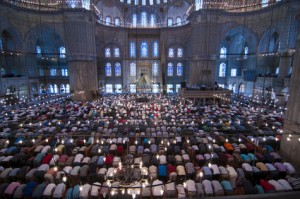Jonathan Morgan
 Back in the sixties, the American sociologist Peter Berger proposed the Secularization Hypothesis – a fancy term for the theory that as cultures become more modern, they will move out from under the umbrella of religion. This change could be seen in a number of ways. It could show up as a declining importance of religion in organizations; think about hospitals, many of which still bear religious names, but not much else religious. Or secularization could show up as fewer and fewer people professing belief or affiliation.
Back in the sixties, the American sociologist Peter Berger proposed the Secularization Hypothesis – a fancy term for the theory that as cultures become more modern, they will move out from under the umbrella of religion. This change could be seen in a number of ways. It could show up as a declining importance of religion in organizations; think about hospitals, many of which still bear religious names, but not much else religious. Or secularization could show up as fewer and fewer people professing belief or affiliation.
Berger recanted his theory and now argues that development leads to a diversity of religions, but the secularization debate continues. And the debate persists for a good reason – it’s really difficult to gain a clear picture of how religion is changing among individuals, communities, and cultures. Over the next few weeks I’m going to review some of the research that tries to follow religious change.
The Pew Research Center’s Forum on Religion & Public Life, is one of the most prominent and thorough groups measuring religion. On their website you can find data on how religion relates to issues like gay marriage or stem-cell research. If you’re interested in how geography or income relates to religion, they have those stats as well.
So if you want to know whether religion is declining in America or the world, this is a good place to start. Last year, they published a report precisely on this issue. The main finding was that one in five adults in America claim no religious affiliation. This is a 5% jump over five years. But it’s important to distinguish who they’re really talking about.
The “Nones” (so called for answering “none-affiliated” on surveys) are comprised of atheists, agnostics, and those who claim no particular religion. As you can imagine, there’s a pretty wide ideological range between a convinced atheist and someone who’s just not particularly affiliated. Atheists account for 2.4% of the population, while those who claim “nothing in particular” represent nearly 14% of the population. If you are curious about secularization, it’s important to note that the 5% increase is primarily an increase in this latter group, not the atheists (sorry Dawkins).
Before asking “why?” it’s worth looking even more closely at the specific beliefs of this group. Surprisingly, a third of the unaffiliated still describe religion as a somewhat or very important part of their lives. These statistics re-iterate the wide diversity of beliefs grouped together as “nones,” since over two-thirds of them claim belief in God or a Universal Spirit.
If you think about secularization as a decline in individual belief, then these stats seem to disprove the theory. The percentage of atheists has only risen .8% over the past five years. Instead, the Pew Forum seems to say that religious belief isn’t diminishing; it’s just changing. But if you think of secularization as a decline in the authority of religious institutions, then you might see the rise of the unaffiliated as a sign of diminishing religious authority. This may be closer to the truth, but the jury is still out. However you interpret the statistics, the debate continues and so will our review.
